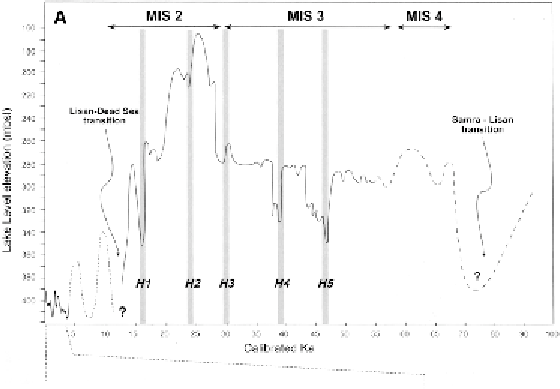Geoscience Reference
In-Depth Information
Figure. 11.5. Fluctuations in Lake Lisan, the Pleistocene precursor of the Dead Sea.
(After Bookman et al.,
2006
, fig. 4.)
followed by a wet pulse of moderate amplitude at 23-19 ka, coinciding with the LGM.
Humidity increased sharply from 16.5 ka onwards, attaining a peak at 13.0-12.5 ka,
after which the climate became drier, with a longer and more pronounced dry season.
In contrast to the humid LGM at Lake Masoko, Lakes Tanganyika and Rukwa located
further north experienced a dry LGM, with a rapid change to wetter conditions by
15 ka (Gasse et al.,
2008
).
11.7 Desert lakes of the Near East
There are sporadic records of previously high lake levels in the deserts of Syria,
Jordan, Arabia and Iran. Of these, the Arabian lakes are the most reliably dated
(McClure,
1976
; Singhvi et al.,
2012
), but the overall record is still fragmentary and
does not extend very far back, in contrast to the lakes of the African Rift Valleys.
One exception to this otherwise patchy record from the Near East is Pleistocene Lake
Lisan, the precursor to the present-day Dead Sea, which has received detailed and
exemplary geochemical and sedimentological study (see reviews in Enzel et al.,
2006
)
and is also now quite reliably dated (Machlus et al.,
2000
; Bartov et al.,
2002
; Enzel
et al.,
2003
; Bartov et al.,
2006
; Bookman et al.,
2006
; Enzel et al.,
2006
; Stein and
Goldstein,
2006
; Prasad et al.,
2009
).
This work has demonstrated that Lake Lisan originated around 75 ka from a very
low level of about 385 m below sea level (
280 m soon
after 70 ka and fluctuated at about that level until around 48 ka (
Figure 11.5
). The
lake level then fell rapidly to
−
385 m), rose rapidly to
−
−
350 m at 46 ka (coeval with Heinrich event H5) and

